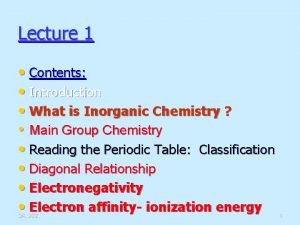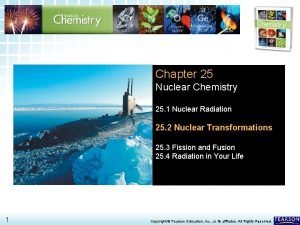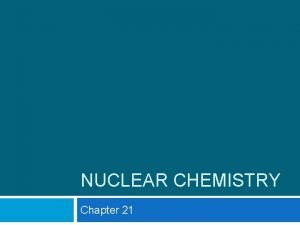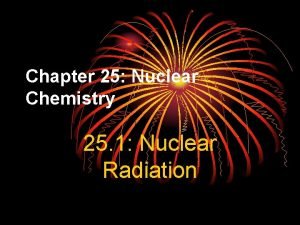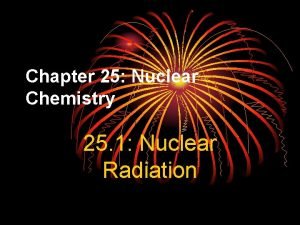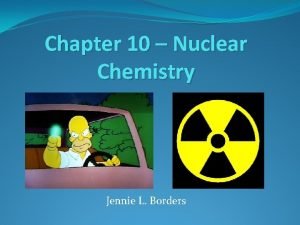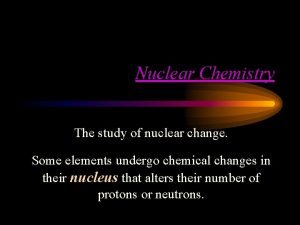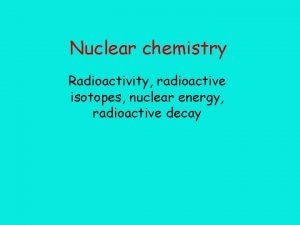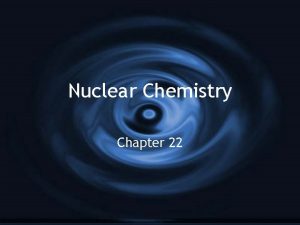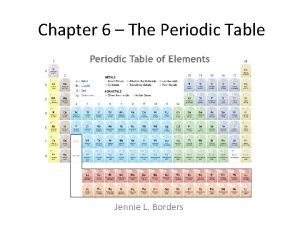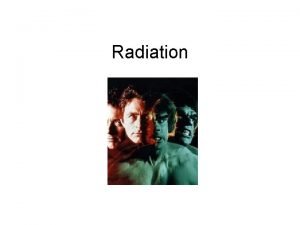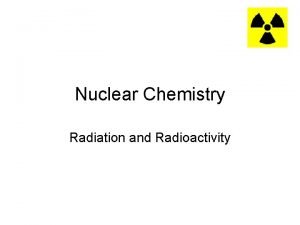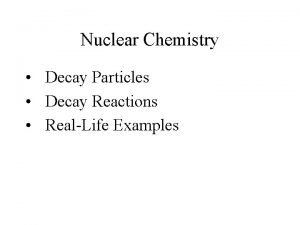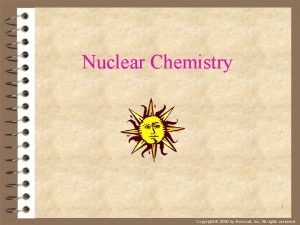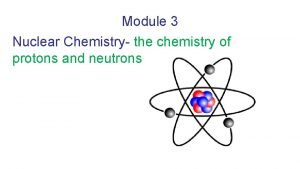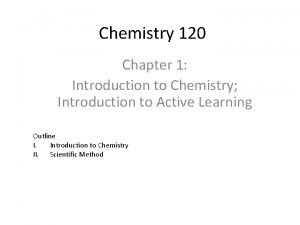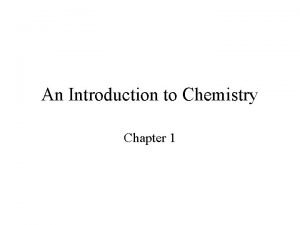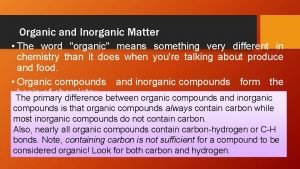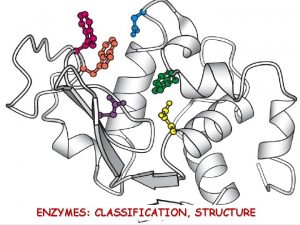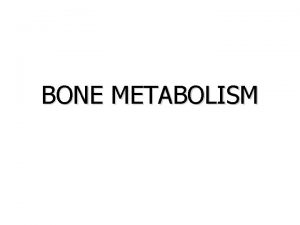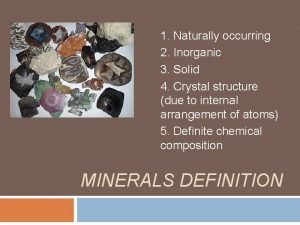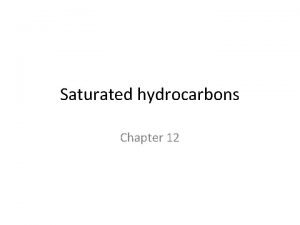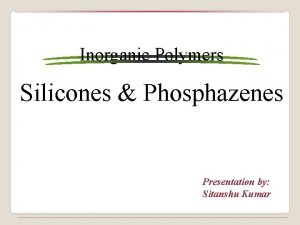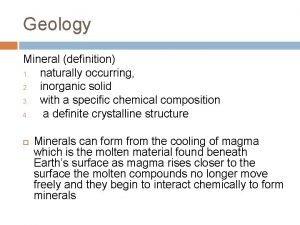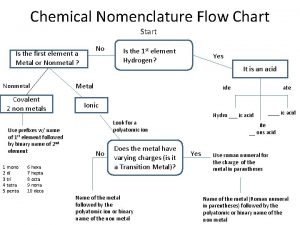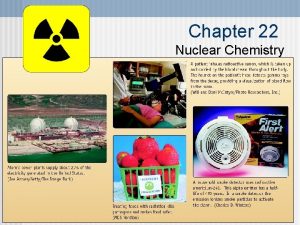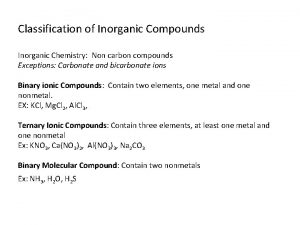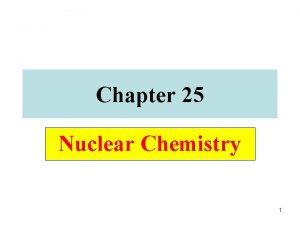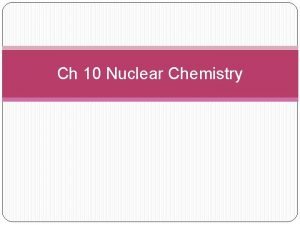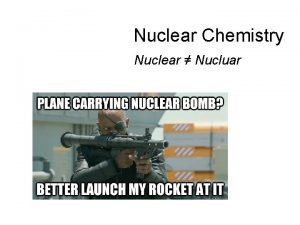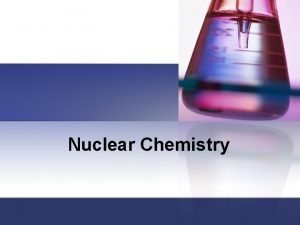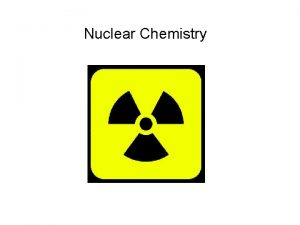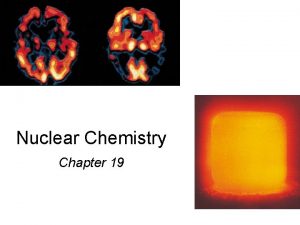Chapter 11 Nuclear Chemistry Introduction to Inorganic Chemistry






















































- Slides: 54

Chapter 11. Nuclear Chemistry Introduction to Inorganic Chemistry Instructor Dr. Upali Siriwardane (Ph. D. Ohio State) E-mail: upali@latech. edu Office: 311 Carson Taylor Hall ; Phone: 318 -257 -4941; Office Hours: MWF 8: 00 -9: 00 and 11: 00 -12: 00; TR 10: 00 -12: 00 Contact me trough phone or e-mail if you have questions Online Tests on Following days March 24, 2017: Test 1 (Chapters 1 -3) April 10, 2017 : Test 2 (Chapters 4 -5) April 28, 2017: Test 3 (Chapters 6, 7 &8) May 12, 2017 : Test 4 (Chapters 9, 10 &11) May 15, 2017: Make Up Exam: Chapters 1 -11).

Chapter 11 Table of Contents 11. 1 11. 2 11. 3 11. 4 11. 5 11. 6 11. 7 11. 8 11. 9 11. 10 11. 11 11. 12 11. 13 Stable and Unstable Nuclides The Nature of Radioactive Emissions Equations for Radioactive Decay Rate of Radioactive Decay Transmutation and Bombardment Reactions Radioactive Decay Series Detection of Radiation Chemical Effects of Radiation Biochemical Effects of Radiation Sources of Radiation Exposure Nuclear Medicine Nuclear Fission and Nuclear Fusion Nuclear and Chemical Reactions Compared Copyright © Cengage Learning. All rights reserved 2

Section 11. 1 Stable and Unstable Nuclides Nuclear Reaction • A reaction in which changes occur in the nucleus of an atom (not ordinary chemical reactions). • Nuclide – an atom with a specific atomic number and a specific mass number. • Atomic Number (Z) – number of protons • Mass Number (A) – sum of protons and neutrons Copyright © Cengage Learning. All rights reserved 3

Section 11. 1 Stable and Unstable Nuclides • Stable nuclide – nuclide with a stable nucleus; does not readily undergo change. • Unstable nuclide – nuclide with an unstable nucleus; spontaneously undergoes change. Copyright © Cengage Learning. All rights reserved 4

Section 11. 1 Stable and Unstable Nuclides Radioactivity • Radiation spontaneously emitted from an unstable nucleus. • Radioactive nuclide (radionuclide) – a nuclide with an unstable nucleus from which radiation is spontaneously emitted. Copyright © Cengage Learning. All rights reserved 5

Section 11. 1 Stable and Unstable Nuclides Radioactive Stability • There is a correlation between nuclear stability and the total # of nucleons found in a nucleus. • Nuclides with 84 or more protons are unstable. Copyright © Cengage Learning. All rights reserved 6

Section 11. 1 Stable and Unstable Nuclides Radioactive Stability • There is a correlation between nuclear stability and neutron-to-proton ratio in a nucleus. • Light nuclides are stable when Z equals A – Z (neutron/proton ratio is 1). • For heavier elements the neutron/proton ratio required for stability is greater than 1 and increases with Z. Copyright © Cengage Learning. All rights reserved 7

Section 11. 2 The Nature of Radioactive Emissions Understanding Radioactivity 1. Certain nuclides possess unstable nuclei. 2. Nuclides with unstable nuclei spontaneously emit energy (radiation). Copyright © Cengage Learning. All rights reserved 8

Section 11. 2 The Nature of Radioactive Emissions Alpha Particle • A particle in which two protons and two neutrons are present that is emitted by certain radioactive nuclei. Copyright © Cengage Learning. All rights reserved 9

Section 11. 2 The Nature of Radioactive Emissions Beta Particle • Particle whose charge and mass are identical to those of an electron that is emitted by certain radioactive nuclei. Copyright © Cengage Learning. All rights reserved 10

Section 11. 2 The Nature of Radioactive Emissions Gamma Ray • Form of high-energy radiation without mass or charge that is emitted by certain radioactive nuclei. Copyright © Cengage Learning. All rights reserved 11

Section 11. 3 Equations for Radioactive Decay • Process by whereby a radionuclide is transformed into a nuclide of another element as a result of the emission of radiation from its nucleus. • Parent nuclide – nuclide that undergoes decay • Daughter nuclide – nuclide that is produced Copyright © Cengage Learning. All rights reserved 12

Section 11. 3 Equations for Radioactive Decay How Nuclear Equations Differ From Chemical Equations 1. The symbols in nuclear equations stand for nuclei rather than atoms. 2. Mass numbers and atomic numbers (nuclear charge) are always specifically included in nuclear equations. 3. The elemental symbols on both sides of the equation frequently are not the same in nuclear equations. Copyright © Cengage Learning. All rights reserved 13

Section 11. 3 Equations for Radioactive Decay • Alpha Particle Decay ( ): Copyright © Cengage Learning. All rights reserved 14

Section 11. 3 Equations for Radioactive Decay • Beta Particle Decay ( ): Copyright © Cengage Learning. All rights reserved 15

Section 11. 3 Equations for Radioactive Decay • Gamma Ray Emission ( ): Copyright © Cengage Learning. All rights reserved 16

Section 11. 3 Equations for Radioactive Decay Concept Check Which of the following produces a β particle? Copyright © Cengage Learning. All rights reserved 17

Section 11. 3 Equations for Radioactive Decay Concept Check Which of the following produces a β particle? Copyright © Cengage Learning. All rights reserved 18

Section 11. 4 Rate of Radioactive Decay Half-Life • Time required for one-half of a given quantity of a radioactive substance to undergo decay. • The greater the decay rate for a radionuclide, the shorter its half-life. Copyright © Cengage Learning. All rights reserved 19

Section 11. 4 Rate of Radioactive Decay of 80. 0 mg of 131 I Copyright © Cengage Learning. All rights reserved 20

Section 11. 4 Rate of Radioactive Decay Half-Life of Nuclear Decay To play movie you must be in Slide Show Mode PC Users: Please wait for content to load, then click to play Mac Users: CLICK HERE Copyright © Cengage Learning. All rights reserved 21

Section 11. 4 Rate of Radioactive Decay Half-Life (n) Amount of radionuclide undecayed after n half-live Copyright © Cengage Learning. All rights reserved original amount of radionuclide 22

Section 11. 4 Rate of Radioactive Decay Exercise The half-life of technetium-99 is 5. 98 hours. How much, in grams, of a 0. 75 -g sample of technetium-99 will remain undecayed after a period of 16 hours? Copyright © Cengage Learning. All rights reserved 23

Section 11. 4 Rate of Radioactive Decay Exercise The half-life of technetium-99 is 5. 98 hours. How much, in grams, of a 0. 75 -g sample of technetium-99 will remain undecayed after a period of 16 hours? 0. 12 g Copyright © Cengage Learning. All rights reserved 24

Section 11. 5 Transmutation and Bombardment Reactions Transmutation Reaction • A nuclear reaction in which a nuclide of one element is changed into a nuclide of another element. Copyright © Cengage Learning. All rights reserved 25

Section 11. 5 Transmutation and Bombardment Reactions Bombardment Reaction • A nuclear reaction brought about by bombarding stable nuclei with small particles traveling at very high speeds. – Always two reactants and two products. Copyright © Cengage Learning. All rights reserved 26

Section 11. 5 Transmutation and Bombardment Reactions Synthetic Elements • Over 2000 bombardment-produced radionuclides are known. • Transuranium elements – occur right after uranium on the periodic table (elements 93 to 118). • All nuclides of all elements beyond bismuth (Z = 83) in the periodic table are radioactive. Copyright © Cengage Learning. All rights reserved 27

Section 11. 6 Radioactive Decay Series • A series of radioactive decay processes beginning with a long-lived radionuclide and ending with a stable nuclide of lower atomic number. Copyright © Cengage Learning. All rights reserved 28

Section 11. 6 Radioactive Decay Series Example Copyright © Cengage Learning. All rights reserved 29

Section 11. 7 Chemical Effects of Radiation • Photographic plates • Geiger counter Copyright © Cengage Learning. All rights reserved 30

Section 11. 7 Chemical Effects of Radiation Film Badges Are Used to Determine a Person’s Exposure to Radiation Copyright © Cengage Learning. All rights reserved 31

Section 11. 7 Chemical Effects of Radiation Geiger Counter Copyright © Cengage Learning. All rights reserved 32

Section 11. 8 Biochemical Effects of Radiation Two Things Can Happen to an Electron Subjected to Radiation • Excitation – occurs when radiation, through energy release, excites an electron from an occupied orbital into an empty, higher-energy orbital. • Ionization –occurs when the radiation carries enough energy to remove an electron from an atom or molecule. Copyright © Cengage Learning. All rights reserved 33

Section 11. 8 Biochemical Effects of Radiation Nonionizing Radiation vs. Ionizing Radiation • Nonionizing radiation – radiation with insufficient energy to remove an electron from an atom or molecule. § Examples: radiowaves, microwaves, infrared light, and visible light • Ionizing radiation – radiation with sufficient energy to remove an electron from an atom or molecule. § Examples: cosmic rays, X rays, and UV light Copyright © Cengage Learning. All rights reserved 34

Section 11. 8 Biochemical Effects of Radiation Ion Pair Formation • Incoming radiation transfers sufficient energy into a molecule to knock an electron out of it, converting the molecule into a positive ion. § H 2 O + , e – Copyright © Cengage Learning. All rights reserved 35

Section 11. 8 Biochemical Effects of Radiation Ion Pair Formation Copyright © Cengage Learning. All rights reserved 36

Section 11. 8 Biochemical Effects of Radiation Free Radical Formation • Usually accompanies ion pair formation. • Free radical – an atom, molecule, or ion that contains an unpaired electron; usually a very reactive species. • H 2 O + Copyright © Cengage Learning. All rights reserved or • OH 37

Section 11. 9 Detection of Radiation Alpha Particle Effects • Have low penetrating power and cannot penetrate the body’s outer layers of skin. • Major damage occurs when alpha-emitting radionuclides are ingested (contaminated food). Copyright © Cengage Learning. All rights reserved 38

Section 11. 9 Detection of Radiation Beta Particle Effects • Can penetrate much deeper than alpha particles and can cause severe skin burns if their source remains in contact with the skin for an appreciable amount of time. • Internal exposure to beta radiation is as serious as internal alpha exposure. Copyright © Cengage Learning. All rights reserved 39

Section 11. 9 Detection of Radiation Gamma Radiation Effects • Readily penetrate deeply into organs, bone, and tissue. Copyright © Cengage Learning. All rights reserved 40

Section 11. 9 Detection of Radiation Alpha, Beta, and Gamma Radiation Differ in Penetrating Ability Copyright © Cengage Learning. All rights reserved 41

Section 11. 10 Sources of Radiation Exposure Background Radiation • Radiation that comes from natural sources to which living organisms are exposed on a continuing basis. Copyright © Cengage Learning. All rights reserved 42

Section 11. 10 Sources of Radiation Exposure Sources of Background Radiation • • Cosmic radiation Rocks and minerals Food and drink Radon seepage in buildings Copyright © Cengage Learning. All rights reserved 43

Section 11. 10 Sources of Radiation Exposure Components of the Estimated Annual Radiation Exposure Copyright © Cengage Learning. All rights reserved 44

Section 11. 11 Nuclear Medicine • A field of medicine in which radionuclides are used for diagnostic and therapeutic purposes. Copyright © Cengage Learning. All rights reserved 45

Section 11. 11 Nuclear Medicine Criteria Used in Selecting Radionuclides • At low concentrations, the radionuclide must be detectable by instrumentation placed outside the body. • Radionuclide must have a short half-life. • Radionuclide must have a known mechanism for elimination from the body. • The chemical properties of the radionuclide must be such that it is compatible with normal body chemistry. Copyright © Cengage Learning. All rights reserved 46

Section 11. 11 Nuclear Medicine Diverse Uses of Radionuclides in the Human Body • • • Determination of blood volume. Location of sites of infection. Diagnosis of impaired heart muscle. Location of impaired circulation. Assessment of thyroid activity. Determination of tumor size and shape. Copyright © Cengage Learning. All rights reserved 47

Section 11. 11 Nuclear Medicine Therapeutic Uses for Radionuclides • Selectively destroy abnormal (usually cancerous) cells. • The radionuclide is often, but not always, placed within the body. Copyright © Cengage Learning. All rights reserved 48

Section 11. 12 Nuclear Fission and Nuclear Fusion Fission Reactions • A nuclear reaction in which a large nucleus (high atomic number) splits into two medium-sized nuclei with the release of several free neutrons and a large amount of energy. • Basis for operation of nuclear power plants. § Uranium-235 Copyright © Cengage Learning. All rights reserved 49

Section 11. 12 Nuclear Fission and Nuclear Fusion Characteristics of the U-235 Fission Reaction 1. There is no unique way in which the U-235 nucleus splits. 2. Very large amounts of energy are emitted during this process. 3. Neutrons, which are reactants in the fission process, are also produced as products. Copyright © Cengage Learning. All rights reserved 50

Section 11. 12 Nuclear Fission and Nuclear Fusion Copyright © Cengage Learning. All rights reserved 51

Section 11. 12 Nuclear Fission and Nuclear Fusion A Fission Chain Reaction Copyright © Cengage Learning. All rights reserved 52

Section 11. 12 Nuclear Fission and Nuclear Fusion Reactions • A nuclear reaction in which two small nuclei are collided together to produce a larger nucleus and a large amount of energy. • Opposite of nuclear fission. • How the sun generates its energy. Copyright © Cengage Learning. All rights reserved 53

Section 11. 13 Nuclear and Chemical Reactions Compared Copyright © Cengage Learning. All rights reserved 54
 Inorganic chemistry vs organic chemistry
Inorganic chemistry vs organic chemistry Importance of pharmaceutical inorganic compound
Importance of pharmaceutical inorganic compound Inert pair effect
Inert pair effect Lesson 15 nuclear quest nuclear reactions
Lesson 15 nuclear quest nuclear reactions Fisión nuclear vs fision nuclear
Fisión nuclear vs fision nuclear Chapter 24: nuclear chemistry answer key
Chapter 24: nuclear chemistry answer key Chapter 25 nuclear chemistry answer key
Chapter 25 nuclear chemistry answer key Chapter 21 review nuclear chemistry
Chapter 21 review nuclear chemistry Chapter 25 nuclear chemistry
Chapter 25 nuclear chemistry Chapter 25 nuclear chemistry
Chapter 25 nuclear chemistry Chapter 10 nuclear chemistry
Chapter 10 nuclear chemistry Chapter 10 nuclear chemistry
Chapter 10 nuclear chemistry Advanced inorganic chemistry lecture notes
Advanced inorganic chemistry lecture notes Organic vs inorganic
Organic vs inorganic Hsab principle
Hsab principle Chernobyl nuclear disaster webquest
Chernobyl nuclear disaster webquest Nuclear chemistry
Nuclear chemistry Application of nuclear chemistry
Application of nuclear chemistry Application of nuclear chemistry
Application of nuclear chemistry What is nuclear charge in chemistry
What is nuclear charge in chemistry Nuclear chemistry review worksheet answer key
Nuclear chemistry review worksheet answer key 25 m/s
25 m/s Nuclear chemistry
Nuclear chemistry Rectangle real life examples
Rectangle real life examples Copyright
Copyright Nitrogen-13 decay equation
Nitrogen-13 decay equation Irradiated food
Irradiated food Chapter 1 introduction to chemistry
Chapter 1 introduction to chemistry Introduction to chemistry chapter 1
Introduction to chemistry chapter 1 Smear layer in dentistry
Smear layer in dentistry Charring test of organic and inorganic compounds
Charring test of organic and inorganic compounds Inorganic plants
Inorganic plants Which compound is inorganic
Which compound is inorganic Introduction to organic chemistry
Introduction to organic chemistry Organic molecules vs inorganic molecules
Organic molecules vs inorganic molecules What is inorganic matter
What is inorganic matter Inorganic mineral definition
Inorganic mineral definition Organic and inorganic cofactors
Organic and inorganic cofactors Organic vs inorganic compounds
Organic vs inorganic compounds An example of prosthetic group
An example of prosthetic group Dry gum and wet gum method
Dry gum and wet gum method Organic and inorganic cofactors
Organic and inorganic cofactors Inorganic catalyst vs enzyme
Inorganic catalyst vs enzyme Organic matrix of bone
Organic matrix of bone Inorganic nomenclature worksheet
Inorganic nomenclature worksheet Inorganic gaseous pollutants of air
Inorganic gaseous pollutants of air Inorganic mineral definition
Inorganic mineral definition Which compound is inorganic
Which compound is inorganic Organic vs inorganic compounds
Organic vs inorganic compounds Silicone inorganic polymer
Silicone inorganic polymer Inorganic gaseous pollutants of air
Inorganic gaseous pollutants of air Inorganic definition geology
Inorganic definition geology Inorganic content of calculus
Inorganic content of calculus Chemistry nomenclature flow chart
Chemistry nomenclature flow chart Gravimetric methods of analysis
Gravimetric methods of analysis


